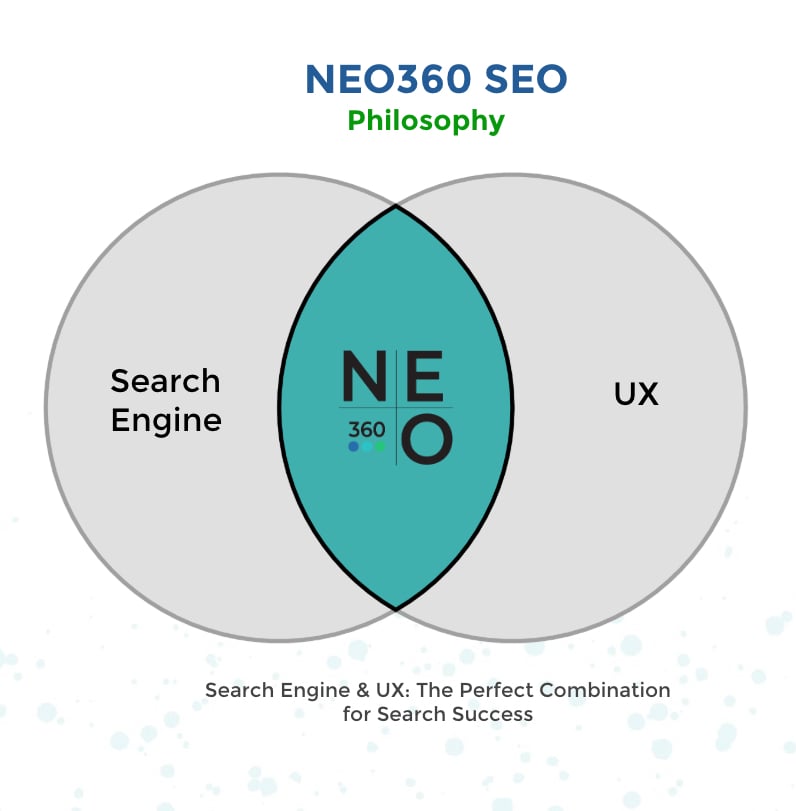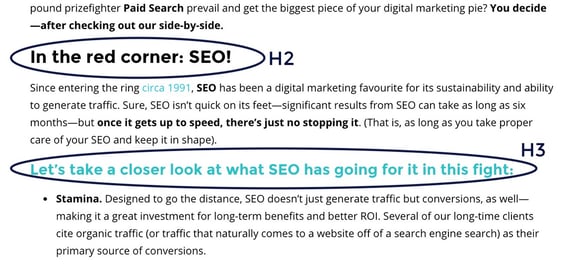10 TIPS FOR OPTIMISING AN SEO and UX-FRIENDLY BLOG
Do you want to improve your ranking in Google using your writing skills? That’s great. But having mad writing skills isn’t enough.
If you want to create a good blog post that scores highly in terms of search engine optimisation or SEO, the first thing you need to do is to understand the relationship between search engines and the user experience.
It sometimes happens that the very people we’re supposed to be writing for in the first place, become neglected in the mad scramble to optimise for search. A regrettable example would be how keyword placement would sometimes end up taking precedence over flow or plain sense—reads funny, but hey, the Google bots like it. Or so you think.
The fact of the matter is Google itself considers the user experience or UX as a ranking factor. And in a Search Engine Land poll, 94% of SEO professionals say that user experience or UX does have an impact on ranking.

10 things SEO and UX love about your content
So while it is important, of course, to keep those tireless search engine trawlers in mind when you write, make sure you don’t forget about your readers, or the users of your website in mind.
Will your website users tire of reading your blog, and bounce right off to somewhere else with more interesting things to read? Or, will they like your post so much they’ll want to share it with someone else?
As the writer of what they read, it’s all up to you. Here are 10 ways to help you optimise your blog posts for both SEO and the user experience that’ll have the Google bots and your blog readers crawling back for more.
1. Reader First.
When you write, put the people who are reading your work on top of the search engine. It may sound counter-intuitive at first blush, because after all, there’s no point in making people-friendly content if the search engine can’t find it to serve it up to them in the first place.
But when you consider that even the search engines want you to write people-friendly blogs, then it makes more sense. This is especially true for things like making sure that the page with your blog on it loads in under 3 seconds.
Reading your blog should be a pleasant experience for your website user, and we’re sure you understand that waiting for your blog to load is anything but fun. Take too long and they’re bound to bounce.
But ultimately, make sure you know your readers’ buyer persona inside out, so you can write the kind of content that you know they’ll find helpful, and enjoy.
2. Make Headlines.
Writing headlines with the readers foremost in mind means making headlines that make them want to tap or click—but, this doesn’t mean resorting to clickbait. Be honest with your reader, in that what you offer them in your headline, must be exactly what they’ll find in the content’s entirety.
Keep your headlines concise; 60 characters is the recommended length, as our research suggests you can expect about 90% of your headlines to display properly in search engine results (i.e. they won’t get cut off). SEO also recommends that you put search terms at the beginning of the headline or as close to it as possible.
This recommendation may also work in terms of reader-friendliness because it’s like telling them straight up, “this is what this blog is about”, “this is what you’re looking for”. After all, don’t you want your readers to find what they need as quickly as possible?
3. Meta Morphosis.
Meta titles and descriptions are kind of like the “free taste” samples they give out at the supermarket—once you get a load of how scrumdiddlyumptious Granny Brand fudge squares are, you might be more likely to buy.
When writing meta titles for your blogs, don’t just describe what your blog is about, but try to convince your reader as to why they need to read your content. Show them how they stand to benefit from your content and use the active voice to help you get your message across.
Of course, fitting all those reasons into 155 to 160 characters is a tall order, but the thing is, any longer than that gets cut off in the results pages. There are tools such as SERPsim that can help you with this, but it also helps to make sure all the important stuff like keywords are closer to the beginning of the meta, just in case.
4. Ballistic Statistics.
Put bluntly, Google is a sucker for statistics—but that doesn’t mean they’re no good for your website users, either. If anything, including statistics in your content the right way can help boost credibility (your own, as well as your blog’s) in your readers’ eyes, as well as give them some added information that they’ll find fascinating, if not useful.
Try to include the statistics closer to the beginning your blog, and if they’re not from your own company or research, make sure they come from a reputable source (which you can link to, as well).
Of course, don’t just stick those statistics in there without a solid introduction, not just to them but to the entire blog. A good introductory paragraph is crucial to keeping your readers on the page and encouraging them to read on till the very end.
5. Heads Up!
The better a search engine understands your content, the more likely it will be present it to your target readers as something they should read (first). In trying to figure out whether they should present your blog to potential readers instead of your competitors’ content, search engines look at H2 and H3 (or Headline 2 and Headline 3) tags.
These H2’s and H3’s correspond to the copyheads that break up blogs into easily digestible chunks for your website users. Copyheads are important not just for making long-form blogs easier for your human readers to read, but also for maintaining the logical, storytelling flow of the entire blog, overall.

Adding variations of the search terms in your H2’s or H3’s at least once will be a big help to search engines. For example, if you’re writing a blog for people using the search term, “hair transplant cost in Singapore”, you might use “How much is a hair transplant in Singapore?” as an H2 or H3.
One way to figure out what to use as H2’s or H3’s is to take a look at the “People also ask” section in Google’s results.

Beware, however, of getting so caught up in sticking search terms into your copyheads that they no longer make sense or affect the quality of the content you provide your human readers.
Say you were writing a blog that focused primarily on hair transplant cost. If you were to use all four of the “People also ask” results above, adding in an H2 or H3 about the success rate or the countries may seem forced (or worse, may not exactly line up with what your reader needs at the moment in terms of their buyer’s journey.)
As important as H2’s and H3’s are, be sure not to lose sight of your main objective, i.e. keeping your website users reading, so that they can find the information they need, from you.
6. Pictures Perfect.
Ask any picture book author (or illustrator) and they’ll tell you how a good picture doesn’t just complement but reinforces what is said in the text. With this in mind, try to be a little more thoughtful when choosing images to go with your blog.
If, for instance, your blog is about the fear of the pain of tattoo removal, don’t just put a photo of a tattoo or of a doctor with a laser device—try finding a picture of someone looking scared, instead.
Creating new images (whether you shoot or illustrate) if you can manage it, is much better than using stock images as this will make your content unique. But whether you purchase or create your images, don’t forget to add a descriptive file name and ALT text to your image to help search engines appreciate your images, too.
7. Go long!
The primary aim of any piece of content is to help people (or at least, it should be). Your website users are looking for information that will help them solve a particular problem.
If, for instance, that problem is chronic knee pain, you’re not going to be of much help to your poor, suffering readers if you just spend 300 words telling them to chuck an ice pack on it. If you really care about helping these people, you’re going to share all the information you can about what’s causing their knee pain, what they can do about it, when it’s time to see a doctor, and what the doctor is likely to do to help them out.
And if you have less altruistic motives for business blogging, consider this: Long-form content gets an average of 77.2% more links than short articles, making blogs with a bigger word count ideal for backlink acquisition.
Now this doesn’t mean that you should start padding your content with fluff just to make the word count (or the user won’t find your content really helpful anyway and they’ll bounce just the same). But more often than not, the more helpful you want to be, the more information you end up adding and the word count just builds up naturally.
8. Cluster Together.
Say you’re sick of dealing with unwanted hair, and you asked a friend for advice. Wouldn’t you appreciate it more if your friend told you about lasers, and what you can expect when you use them, along with how much you can expect to spend and so on? (Instead of just handing you a razor and telling you to grin and bear it.)
Each of those bits of information can easily become a full-length blog, so to make it easier for people who are looking for all those related bits of information, you can group all those blogs together into a topic cluster. When done correctly, topic clusters can increase your authority and make you more relevant in the eyes of your readers.
The good news is that not only do clusters make things easier for website users, but they also make it easier for Google to understand the hierarchy of your website. (And making things easier for Google, makes it easier for you to rank.)
9. Take Action!
What writer, of any kind, wants people to forget about his work as soon as they’ve read it? It’s not enough to get people to read it; as a writer, you want your work to move your readers, to inspire them, to make them do something about what they’ve read.
When it comes to content marketing, the best way to do this is to tell your website users exactly what you want them to do, and this, in marketing parlance, is the call to action or CTA. Adding CTA’s to your content helps to increase the average time spent on your page and to reduce bounce rate.
This doesn’t mean, however, that you get out there and add CTA’s to your content every which where, or add just any ol’ CTA. Calls to action need to be added strategically, which means not just choosing the right places to add them, but formulating them carefully according to your reader’s buyer’s journey.
For example, a CTA asking your readers to book an appointment at your clinic within an awareness stage blog isn’t exactly a good idea, since they’ve only just become aware of a particular solution to their problem. A better CTA for this blog, instead, might be ask them to check out your other, related blogs for more information on the topic.
10. Love Links.
When building a relationship with someone, it helps to be proactive. Instead of just waiting for circumstances to bring a person closer to you, actually reaching out to a person and getting some interaction going is far more likely to produce results, more quickly. The same goes for linkbuilding.
Very simply, linkbuilding is getting people to link back to your blogs, which, in the eyes of search engines, boosts your blogs’ authority (and consequently, your ranking). If you know you’ve created the best content you can to help people, you shouldn’t be ashamed to reach out to other websites to ask them to share or link back to you.
Think of these links back to your blogs as electoral votes, and whoever gets the most votes get the top spots in search engine results. Normally, it’s the good candidates who (should) receive the most votes.
Now, if you’re tempted to cheat your way to “winning the elections” with inferior content, think twice. Running social media ads, let’s say, to boost traffic to content that’s badly written is actually more expensive, because Facebook penalises businesses that boost content that isn’t likely to resonate with their users—score 1 for Facebook, 0 for you.
But don’t think that linkbuilding is exclusively pro-search engine, rather than pro-reader. Linkbuilding is actually a way to help your content reach more readers, allowing the users of other websites (not just your own) to find content that they can use and enjoy.
So you’re not just helping your rankings, but other people, too, and isn’t that what writing and optimising content is all about?
We have a long track record of creating and optimising content that gets business owners just like you found on Google. Check out how NEO360 can help you with your SEO efforts today.
Let’s talk about your marketing performance!
About the Author
Managing Director
A Mechanical Engineer by training who graduated from the Nanyang Technological University. With over 15 years of experience working in Start-Ups, SMEs and MNCs, he has driven sales revenue and leads across the Asia Pacific region. Shei Wah was one of the SEO Speakers at the first Search Engine Strategies Conference 2011 held in Singapore. As Managing Director, he aims to establish NEO360 in all of the world’s major cities. Even as he works toward this goal, Shei Wah also dreams of his children’s future happiness, and unwinds by doing calisthenics with his former school buddies three times a week.





